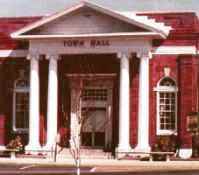| Georgetown, Delaware History | ||
| The Heart of Sussex County.... Everyone knows it. They can feel it. Life in Sussex County is just a little less hectic than in the sister counties to the north. People in Sussex County even have a distinct accent in their voices. Its an old agricultural based community blessed with world class beaches, vital, expanding industries and a special kind of hospitality. Sussex County is often referred to as Delaware's Dixie. Best of all Georgetown is located right in the middle of it all. It's not by accident that Georgetown is "Sixteen Miles from Anywhere" in Delaware's Deep South. Besides serving as the title of a book on the history of Georgetown by William J. Wade, it was the Delaware General Assembly's attempt in 1791 to make everybody happy and centralize things in extremely rural Sussex County. |
|
|
It all started in 1631, when Dutch colonists established the first settlement in Delaware at Lewes. Naturally, since it was first and only settlement for the longest time, Lewes was the prime contender for the Seat of Justice when William Penn later established his three lower counties of Pennsylvania. It wasn't until 1775 when the actual boundaries of Sussex County were firmly established and thus ended a long dispute between the Penn family, which claimed the county extended to Fenwick Island, and Lord Baltimore, who claimed it ended at Lewes. Delaware's own Mason-Dixon Line permanently demarcates the southern and western boundary of the County. While the boundary dispute was being deliberated in England, the three counties became Delaware and settlements were founded on the western side of Sussex County. Much like today, all official government business was conducted at the Seat of Justice in the 1700s. Unfortunately for western Sussex Countians, Lewes was a days travel across some of the most treacherous roads in the newly formed nation and it required a night's lodging to boot. After years of complaining about the expense and travel conditions, western Sussex Countians were successful in petitioning the General Assembly to move the County Seat to a central location, when a law was passed on January 29, 1791. The middle of the county was vast, swampy and largely unsettled, so the legislators selected 10 commissioners and instructed them to purchase land, build a courthouse and jail and sell lots in an area in the center of the County at "James Pettyjohn's old field or about a mile from where Ebenezer Pettyjohn now lives." On May 9, 1791, the 10 commissioners headed by President of the State Senate George Mitchell negotiated the purchase of 76 acres and Commissioner Rhodes Shankland began the survey by laying out "a spacious square of 100 yards each way." Eventually the Town was laid out in a circle one mile across, centered on the original square surveyed by Shankland and now listed on the National Register of Historic Places.
The town continued to grow under the direct administration of the General Assembly, which had to pass laws regulating pigs running at large. (A typical problem of the day, but usually handled by a local government.) Homes were constructed for judges, lawyers and County officials. Taverns, hotel, small businesses and banks were established to serve the needs of the daily visitors and growing population. Several churches were established including St. Paul's Episcopal Church on East Pine Street, Wesley United Methodist Church on North Race Street and Grace United Methodist Church on East Market Street. The County Seat continued to thrive until
it was divided by the Civil War, with sons fighting on
both sides and families torn apart by loyalties for the
South and the North. Though later wars brought no
divisions, Georgetown has given her sons to the service
of the country and a memorial stands in their honor on
the south side of the Courthouse. |
||
| Return to Georgetown Home Page |
[ Brief ] [ History ] [ Chamber ] [ Government ] [ Businesses ] [ Organizations ] [ Schools ] [ Churches ] [ Maps ] [ Dining ] |
Delaware |
Maryland |
News |
Classifieds |
Real Estate |
What's New |
Shopping Mall |
| Internet Hosting, Design & Production: Email Sandmaster Copyright © 1995-2001 "At The Beach Enterprises, Inc." All Rights Reserved P O Box 2179, Ocean City, Maryland 21843 This page URL address - http://www.georgetownde.com/gorghist.html |

 The
Courthouse was constructed on the southeastern side of
the Town square as was the Jail and on October 26, 1791,
the Seat of Justice was officially moved to the new
county seat and named Georgetown in honor of George
Mitchell. Lots were laid out measuring 60 by 120 feet and
sold to recoup the State's investment. The original
Courthouse was replaced by the present structure in 1837,
it was restored in 1976 and now stands on South Bedford
Street and serves as the home of the Georgetown
Historical Society.
The
Courthouse was constructed on the southeastern side of
the Town square as was the Jail and on October 26, 1791,
the Seat of Justice was officially moved to the new
county seat and named Georgetown in honor of George
Mitchell. Lots were laid out measuring 60 by 120 feet and
sold to recoup the State's investment. The original
Courthouse was replaced by the present structure in 1837,
it was restored in 1976 and now stands on South Bedford
Street and serves as the home of the Georgetown
Historical Society.